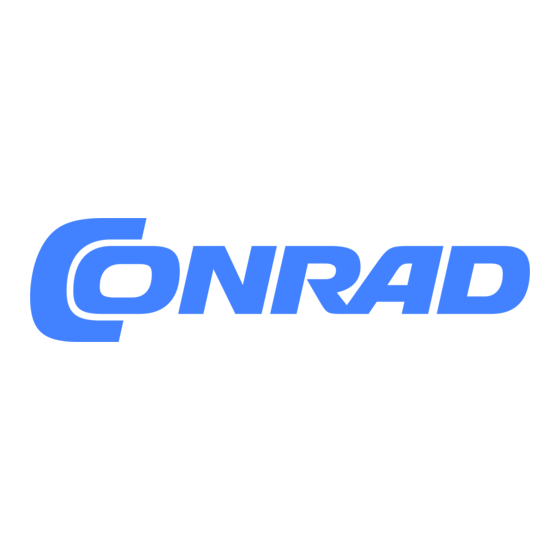
Publicité
Liens rapides
B E D I E N U N G S A N L E I T U N G
Kartenleser USB2.0 blau
Best.-Nr. 41 19 77
Bestimmungsgemäße Verwendung
Das Produkt kann an einen USB-Port eines Computers angeschlossen werden und dient dort
zum Lesen und Beschreiben von entsprechenden Speicherkarten.
Das Produkt entspricht den gesetzlichen, nationalen und europäischen Anforderungen. Alle
enthaltenen Firmennamen und Produktbezeichnungen sind Warenzeichen der jeweiligen
Inhaber. Alle Rechte vorbehalten.
Lieferumfang
• Kartenleser
• USB-Kabel
• Bedienungsanleitung
Merkmale
• USB2.0 (abwärtskompatibel zu USB1.1)
• Verschiedene Speicherkartentypen einsetzbar (z.B. SD/MMC, CF, MS, xD, microSD)
Anschluss
Schalten Sie den Computer ein und warten Sie, bis das Betriebssystem vollständig geladen ist.
Verbinden Sie den Kartenleser über das mitgelieferte USB-Kabel mit einem freien USB-Port
Ihres Computers bzw. USB-Hubs.
Die Treiber sind bereits in Windows enthalten (mindestens Windows ME bzw. XP/Vista erforder-
lich). Windows erkennt den Kartenleser automatisch und installiert alle benötigten Treiber.
Zusätzliche Laufwerksbuchstaben werden von Windows automatisch vergeben.
Abstecken des Kartenlesers
Wenn Lese-/Schreibzugriffe auf die Speicherkarte erfolgen, so warten Sie, bis diese abge-
schlossen sind.
Ziehen Sie erst danach die Speicherkarte vorsichtig aus dem Kartenleser.
Wird die Speicherkarte während einem Lese-/Schreibzugriff herausgezogen, so
können die Daten auf der Speicherkarte beschädigt werden, möglicherweise ist
danach sogar eine neue Formatierung der Speicherkarte erforderlich.
Trennen Sie erst jetzt den Kartenleser vom Computer.
Auslesen/Beschreiben von Speicherkarten
Die Speicherkarte wird wie ein herkömmliches Wechseldatenträger-Laufwerk eingebunden.
Beispielsweise mit dem Dateimanager von Windows können Sie die Daten auf der Speicher-
karte auslesen (oder Daten auf die Speicherkarte ablegen), genauso wie von Festplatte oder
USB-Stick gewohnt.
Tipps & Hinweise
• Beim Löschen oder Beschreiben von Speicherkarten im SD-/MS-Format ist darauf zu achten,
dass der evtl. vorhandene Schreibschutz (Schiebeschalter auf der Speicherkarte) aus-
geschaltet ist.
• Verwenden Sie vorzugsweise einen USB2.0-Port zum Anschluss des Kartenlesers.
Bei USB1.1-Betrieb beträgt die Übertragungsgeschwindigkeit nur etwa max. 800kByte/s.
Abhängig von der Geschwindigkeit der von Ihnen verwendeten Speicherkarte sind bei USB2.0
mehrere MByte/s möglich! Sie sollten deshalb für eine schnellere Übertragung immer einen
USB2.0-Port für den Kartenleser verwenden (enorme Zeitersparnis bei der Datenüber-
tragung).
Entsorgung
Entsorgen Sie das Produkt am Ende seiner Lebensdauer gemäß den geltenden
gesetzlichen Bestimmungen
Diese Bedienungsanleitung ist eine Publikation der Conrad Electronic SE,
Klaus-Conrad-Straße 1, D-92240 Hirschau.
Diese Bedienungsanleitung entspricht dem technischen Stand bei Drucklegung.
Änderung in Technik und Ausstattung vorbehalten.
© Copyright 2008 by Conrad Electronic SE. Printed in Germany.
www.conrad.com
Card Reader USB2.0 blue
Version 04/08
°
Order No. 41 19 77
Intended Use
The product can be connected to a USB port of a computer. It is designed to read and write cor-
responding memory cards.
This product complies with the applicable National and European specifications. All names of
companies and products are trademarks of the respective owner. All rights reserved.
Contents
• Card reader
• USB cable
• Operating instructions
Features
• USB2.0 (compatible down to USB1.1)
• Various types of memory cards applicable (e.g. SD/MMC, CF, MS, xD, microSD)
Connection
Switch your computer on and wait until the operating system is completely booted.
Connect the card reader with a free USB port of your computer or USB hub using the USB cable
provided.
The drivers are already included in Windows (minimum requirement Windows ME or XP/Vista).
Windows recognizes the card reader automatically and installs all necessary drivers. Additional
drive letters are assigned automatically by Windows.
Disconnecting the Card Reader
If there is any read/write access on the memory card, wait until it is finished.
Then, carefully remove the memory card from the card reader.
Disconnect the Card Reader thereafter.
Reading/recording memory cards
The memory card is integrated in the same manner as a conventional replaceable data carrier
drive.
For example, in the Windows file manager you can readout the data of the memory card (or file
data onto the memory card), just like you use the hard disk or USB stick.
Tips & Notes
• Make sure that the possible read-only access of SD/MS cards (slide switch in the memory
card) is switched off when deleting or writing onto memory cards in MS format.
• Use preferably a USB2.0 port to connect the card reader.
The data signalling rate for USB1.1 operation is only max. 800kByte/s.
Depending on the speed of your memory card, with USB2.0, several Mbyte/s are possible!
Therefore, for a fast transfer, you should always use a USB2.0 port for the card reader
(tremendous saving of time during data transfer).
Disposal
© Copyright 2008 by Conrad Electronic SE. Printed in Germany.
O P E R A T I N G I N S T R U C T I O N S
If the memory card is extracted during a read/write access, the data on the memo-
ry card can be damaged. It is possible after that the memory card has to be for-
matted again.
Please dispose of the device when it is no longer of use, according to the current
statutory requirements
These operating instructions are published by Conrad Electronic SE,
Klaus-Conrad-Straße 1, D-92240 Hirschau/Germany.
The operating instructions reflect the current technical specifications at time of
print. We reserve the right to change the technical or physical specifications.
www.conrad.com
Version 04/08
°
Publicité

Sommaire des Matières pour Conrad 41 19 77
- Page 1 The operating instructions reflect the current technical specifications at time of Änderung in Technik und Ausstattung vorbehalten. print. We reserve the right to change the technical or physical specifications. © Copyright 2008 by Conrad Electronic SE. Printed in Germany. © Copyright 2008 by Conrad Electronic SE. Printed in Germany.
- Page 2 Il convient de procéder à l’élimination du produit au terme de sa durée de vie conformément aux prescriptions légales en vigueur Cette notice est une publication de la société Conrad Electronic SE, Deze gebruiksaanwijzing is een publicatie van Conrad Electronic SE.

